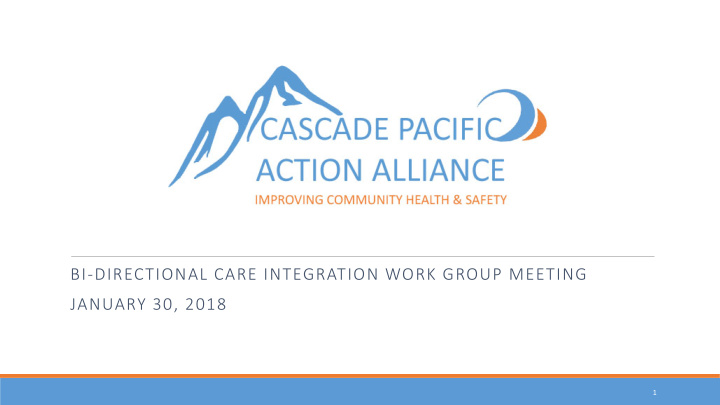



BI-DIRECTIONAL CARE INTEGRATION WORK GROUP MEETING JANUARY 30, 2018 1
Welcome and Introductions Introduce yourself: Name, organization, and county WE WELCOME ME 2
Agenda Review previous meeting 2018 Milestones Updates Target Populations Discuss First Milestone for 2018: Current State Assessment Building an integrated portfolio – focusing on bi-directional care integration at next Council meeting 3
Last Meetings • Waiting for our project plan score and funding amounts • 2018 Milestones • Focused on assessment strategy • Choosing assessments • Defining utility of assessment • Part of partnering provider commitments as QI 4
Project Work Plan Timeline & Milestones - 2018 Select Target Identify & Engage Identify Domain 1 Develop Plan Assess Current State Populations & Project Develop Project Strategies to Support Describing Regional Capacity Evidence Based- Implementation Implementation Plan Project Transition to FIMC Approaches Partners •Describe level of •Completed strategies for •Definition of target •BH & Physical Health •Implementation timeline •Reflect how CPAA region integrated care model HIT, Workforce, & population and evidence- providers, organizations, will enact FIMC by Jan •Strategies that address all Financial Sustainability that based approach and relevant committees 2020 •Explain which models are Medicaid beneficiaries support project or councils in place •Develop plan, description •Justification of evidence- •Secure formal of a process, and timeline •Describe where based approaches commitments for organizations fall in 6 •Roles/responsibilities of participation via a written levels of integrated care implementation partners agreement specific to the •Strategies for ensuring role each partner will long-term sustainability perform DY2, Q4 DY2, Q2 DY2, Q3 5
Clinical Provider Advisory Committee • Discussed Systems/Technology Improvements, VBP, and Formal Commitments • Key Points Explore data/technology work group feasibility • Regional strategy for VBP • Need clarity on commitment letters • Learn what VBP education is needed • Incentives to support Transformation goals • 6
Council Meeting • Thursday, February 8 th from 12:00 – 3:00pm in Mason County Public Works • Shared Learning on bi-directional care integration Overview • Primary care transformation • Success stories • Integrated project portfolio • 7
4 HCA P4R Updates Overview ACHs can earn incentive payments for successfully submitting key deliverables, and ensuring complete and timely reporting by partnering providers on defined metrics within the timeframes set forth by the state. P4R deliverables Semi-Annual Reports Implementation Plan Quarterly Participating Partner Updates Quality Improvement Plan Mid-Point Assessment P4R Metrics Note: deliverable timelines and format are still under development.
8 P4R Deliverable Development DY 2 P4R deliverables ACH Reporting HCA Template Submitted Submission Deliverable Period Release through Deadline Semi-Annual 1/1/2018 – March 2018 7/31/2018 CPAS Report (2.1) 6/30/2018 Implementation N/A April 2018 10/1/2018 CPAS Plan Semi-Annual 7/1/2018 – July 2018 1/31/2019 CPAS Report (2.2) 12/31/2018
Finalizing Target Populations • Patients screened in primary care and behavioral health settings • In PC and BH settings, children and adults: Dx w/ mental illness • Dx w/ serious mental illness • SUD treatment need • Also that have co-occurring chronic conditions (diabetes, asthma, heart disease, obesity) • Questions: • Should we be more specific than this? • How might our target populations influence implementation? • 10
Assess Current State Capacity • Changes to the assessment strategy • Developing a customized assessment including Assess Current State Capacity elements from multiple project areas 1. Describe level of integrated care • Survey settings: primary care and behavioral health model adoption among target providers/organizations 2. Explain which integrated models or practices are in place 3. Describe where organizations fall in 6 levels of integrated care 11
Assess Current State Capacity • Taking a phased approach 1 st phase: To satisfy milestone, “brief” custom survey that • Assess Current State Capacity includes Integrated Practice Assessment Tool (IPAT) 2 nd phase: partnering organizations choose a tool from a • list of integrated care assessments that works best. This 1. Describe level of integrated care tool is used every 6 months and part of implementation model adoption among target providers/organizations plan. 2. Explain which integrated models • Small Group Exercise 1: or practices are in place 3. Describe where organizations • What feedback do you have on this approach? fall in 6 levels of integrated care • What additional information on bi-directional care integration should CPAA gather that is actionable? 12
Building an Integrated Portfolio • Small Group Exercise 2: • What are the main intersection points and opportunities for the other 5 project areas with bi-directional care integration? 2B: Care coordination (Pathways) • 2C: Transitional care • 3A: Opioid Response • 3B: Reproductive/Maternal & Child Health • 3D: Chronic Disease Prevention & Control • 13
Bi-Directional Integration Strategies • Primary Care Settings • Behavioral Health Settings • New team roles • New team roles • BH Care Managers • PC Consultants • Onsite BH Specialists • PC RN Care Managers • Psychiatric Consultants • Onsite PCP provider (MD or ARNP) • Measurement-Based Screening and Follow- • Metabolic screening up (e.g., PHQ-9; GAD-7) • Routine preventative care • SBIRT • Cardiovascular and diabetes care (e.g., BP; • Measurement-based treatment to target A1C) • Accountable for BH quality measures • Accountable for medical quality measures • Medication adherence, including BH • Medication adherence *Washington Council for Behavioral Health 14 CASCADE PACIFIC ACTION ALLIANCE
Re-Evaluating Workgroup Meeting Structure • Quarterly joint meetings w/ breakout sessions • Enhanced communication in-between meetings • Webinars as needed • Localized meetings around region • Are there any suggestions? 15
Summary and Next Steps • Next steps Finalize assessment strategy • Review Domain 1 strategies by project area • What else? • 16
Recommend
More recommend